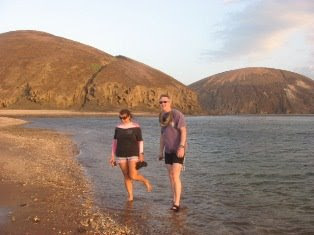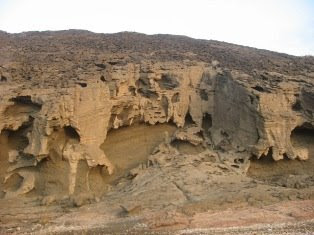 We weren’t the only ones interested in this area as we soon met up with a BBC Natural History film crew who were going to be filming for an up-coming documentary on the East African rift and were keen to find out more about the whale sharks in the area. And so it was that Deli moved up into the western end of the Gulf into an area that has almost become a land locked lake due to volcanic activity and uplift in the area... this is the Ghoubet al Kharab or Devil’s Goblet and is an almost surreal area bounded by volcanic craters and lava flows.
We weren’t the only ones interested in this area as we soon met up with a BBC Natural History film crew who were going to be filming for an up-coming documentary on the East African rift and were keen to find out more about the whale sharks in the area. And so it was that Deli moved up into the western end of the Gulf into an area that has almost become a land locked lake due to volcanic activity and uplift in the area... this is the Ghoubet al Kharab or Devil’s Goblet and is an almost surreal area bounded by volcanic craters and lava flows.The wind at this end of the Gulf was relentless, the ‘khamsin’ wind is caused by air on the mountains being in the North and West being heated more quickly than in the lower sea-level area of the Gulf and increase dramatically through the day… in the Devils Goblet they were intense as the walls of the Goblet funneled the winds from off the sea towards the mountain ranges of Ethopia.
 We anchored in the lee of Devil’s Island a bizarre volcanic plug that looks like Ayre’s rock dropped into the middle of a large lake! We went out for a first whale shark survey around the island but found conditions on the up-wind side almost impossible and opted to do a plankton tow and CTD profile in the lee of the island instead, followed by a few hours exploring these strange islands.The scenery was very odd and was largely due to the volcanic bed rock of the islands which was then covered in layers of volcanic dust and ash several metres thick.
We anchored in the lee of Devil’s Island a bizarre volcanic plug that looks like Ayre’s rock dropped into the middle of a large lake! We went out for a first whale shark survey around the island but found conditions on the up-wind side almost impossible and opted to do a plankton tow and CTD profile in the lee of the island instead, followed by a few hours exploring these strange islands.The scenery was very odd and was largely due to the volcanic bed rock of the islands which was then covered in layers of volcanic dust and ash several metres thick. A landing expedition soon declared the discovery of the islands Apex Predator (a hermit crab) although the team were still convinced that velocoraptors were nesting in the strange round caves carved into the walls of Devils island...So that’s how we came to spend the night anchored in the lee of Devils Island, in the flooded remains of a volcano next to a lava flow that was spawned by the Ardoukoba Volcano in 1978...
although the team were still convinced that velocoraptors were nesting in the strange round caves carved into the walls of Devils island...So that’s how we came to spend the night anchored in the lee of Devils Island, in the flooded remains of a volcano next to a lava flow that was spawned by the Ardoukoba Volcano in 1978...
 although the team were still convinced that velocoraptors were nesting in the strange round caves carved into the walls of Devils island...So that’s how we came to spend the night anchored in the lee of Devils Island, in the flooded remains of a volcano next to a lava flow that was spawned by the Ardoukoba Volcano in 1978...
although the team were still convinced that velocoraptors were nesting in the strange round caves carved into the walls of Devils island...So that’s how we came to spend the night anchored in the lee of Devils Island, in the flooded remains of a volcano next to a lava flow that was spawned by the Ardoukoba Volcano in 1978... Morning arrived and we were still all safe and sound, the Devils Goblet had not swallowed us up in a lava flow and the morning Khamsin wind greeted us as we moved the Deli around the island into the area known simply as ‘the crack’ where the BBC team, Ingrid and Gavin, were filming with an ROV down into the crack between the two tectonic plates.... and apparently there were whale sharks there!
After two hours of luckless searching through the steep sided flooded calderas that are peppered around this area we returned to the Deli and paid a visit to Ingrid and Gavin to see what they were up to with their ROV. The strange contraption was returning from a dive into the crack and we found it bumbling along just above the crack in shallow water, about 25 meters from a young 3.5 m whale shark! This was soon joined by a second shark and shortly a third was seen at some distance from the boat... if the sharks were here then this must be safe after all!

However, three sharks did not a programme make and so it was with some relief that we left the Devil’s Goblet and headed back to Arta and the Ras Korali area to continue our work on the whale shark aggregation... would the sharks be there? We had had a rather disappointing day prior to heading into the Ghoubet and were worried that the massive aggregation may have dispersed for more productive areas.... the evening would tell...

No comments:
Post a Comment